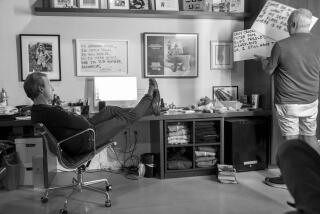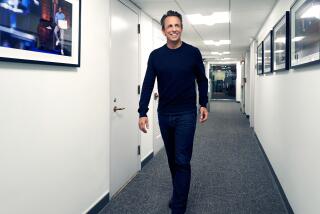A ‘Cat’ with some bite
- Share via
Theodor Geisel wrote “The Cat in the Hat” using just 300 different words. When the film adaptation of the Dr. Seuss classic opens Friday, young moviegoers will encounter some additional vocabulary terms, including hip-hop slang for a prostitute and a four-letter acronym for excrement.
Three years after “How the Grinch Stole Christmas” became a runaway box-office hit, Hollywood is trying again to marry a leading comic with a unique voice in children’s literature. Where Jim Carrey added broad physical comedy to “Grinch,” Mike Myers injects a different brand of humor into “Cat in the Hat,” which features sight and script gags about lactose intolerance, castration and erections.
“I really thought we’d have to trim a couple of scenes,” says Bo Welch, the film’s director and an esteemed production designer, who admits he thought it was “shocking” that the film received a PG rating in its first and only screening before the ratings board.
Based on one of the most adored children’s books of all time, “The Cat in the Hat” appears to have the young moviegoing audience mainly to itself. Last week’s “Looney Tunes” movie fizzled, and the popularity of “Brother Bear” has begun to wane. Outside of next week’s “Haunted Mansion,” most upcoming wide releases are aimed at older patrons. The issue now is whether “The Cat in the Hat” is too naughty to be nice.
One of “Cat in the Hat’s” most controversial sequences involved the Cat’s stumbling upon a muddy garden implement, which he addresses as a “dirty ho.” A number of people who worked on the movie asked that the line be cut for taste, but Myers fought for it. “I had a bet that the joke wouldn’t last. But it did,” Welch says.
Introducing Myers’ particular -- and often risque -- comic style, popularized in the hit “Austin Powers” films, into a family film was not the only challenge faced by the “Cat in the Hat” filmmakers. Before filming could begin, the film’s producer, Brian Grazer, had to make peace with Myers, with whom he had been involved in a nasty legal battle. Once production started, songs written by Randy Newman were ditched because they were deemed inferior. And although Welch and a publicist for Myers deny it, several people say Myers had considerable input into the film’s directing, telling some of the cast (the film co-stars Alec Baldwin and Kelly Preston) how to perform their scenes.
Feud laid to rest
When it was first conceived as a movie in 1997, “The Cat in the Hat” was going to star “Home Improvement’s” Tim Allen. DreamWorks ordered numerous screenplays, but the project never coalesced. Soon after Grazer’s Imagine Entertainment made “How the Grinch Stole Christmas” in 2000 for Universal Pictures, DreamWorks approached Imagine about a possible “Cat in the Hat” co-production involving Imagine, Universal and DreamWorks.
Everyone was willing, and Grazer had the perfect actor in mind to replace Allen. Unfortunately, Grazer and Myers were hardly the best of friends.
The Grazer-Myers clash was sparked by the collapse of the film “Dieter,” a Universal-Imagine film that had Myers reprising a character he played in a “Saturday Night Live” skit. Universal and Imagine said Myers abandoned the project while Myers asked that it be put on hold just weeks before its scheduled 2000 start. In a rare public display of behind-the-scenes antagonism, Universal and Imagine separately sued Myers, and the actor filed a countersuit. Imagine called Myers “egomaniacal,” “irresponsible” and a bigot, while Myers said in his lawsuit that Universal was greedy and had stalked him.
Civil complaints sometimes feature this kind of inflammatory personal language for dramatic effect, but in this instance, the invective was real. Myers and Grazer looked about as likely to collaborate as Bill O’Reilly and Al Franken. If Grazer and Myers were to work together on “Cat in the Hat,” both would have to bury a very bloody hatchet.
But Dr. Seuss can have a strange and seductive effect on people, including adults. Finally, at a meeting early last year at the Peninsula Hotel in Beverly Hills, Grazer and Myers made peace. (The lawsuits were later settled out of court.)
“It’s a little like when you break a bone. It’s really painful at first,” Grazer says of his fight and reconciliation with Myers. “And then, six months later, you are up and on your feet, and the pain is gone.” Myers didn’t comment for this story.
“Grinch” held an obvious moviemaking advantage over “Cat in the Hat,” in that “Grinch’s” lead character changes, and there is an entire world called Whoville in which he evolves from foe to friend. With “Cat in the Hat,” says Welch, “Well, there’s not a lot there. Mom leaves. Cat comes in and trashes the place and cleans it up before she comes home. That’s not much of a movie.”
But it was a start. The Writers Guild of America did not give the “Seinfeld” writing team of Alec Berg, Jeff Schaffer and David Mandel credit for rewriting the “Grinch” screenplay, even though director Ron Howard said the threesome wrote almost all of the movie (the film is credited to the original screenwriters Jeffrey Price and Peter Seaman). The threesome immediately started expanding “Cat in the Hat’s” brief outline.
Says Mandel: “I think we used every ounce of ‘The Cat and the Hat,’ and some of the stuff from its sequel, ‘The Cat in the Hat Comes Back.’ ” But as Berg, Schaffer and Mandel quickly realized, the first book’s basic conceit -- that a mother abandons her young children for the day -- had to go. “People said, ‘Wait. Aren’t we going to think the mom is a monster for leaving her kids alone?’ ” Berg says.
So the writing trio added a lethargic baby sitter, and also concocted a scheming neighbor (Baldwin) who is courting the mom (Preston), giving the plot both an antagonist and a reason for the characters’ leaving the house. While the writers had only five weeks to rework “Grinch” before its cameras started rolling, they had much more time to collaborate with Myers to add gags on the “Cat” script. “He’s very keyed into what’s funny, and he knows what he wants,” Schaffer says.
“What Mike enjoys more than anything else is, ‘This is dirty, but I’m not going to say the word,’ ” adds Berg. “It’s the clean insinuation of dirty things.” Indeed, audience members have to puzzle out the excrement acronym for themselves, and in another sequence, the Cat is interrupted before he can complete a primer on sexual intercourse.
Audrey Geisel, the author’s widow and an overseer of the Dr. Seuss estate, reviewed screenplay drafts, just as she had done on “Grinch.” One of her principal worries: potty humor.
“She is as tough as you get,” Grazer says. “There were a few jokes in the drafts that she felt went too far.” Among them was a scene in which the Cat looks at what is by implication a centerfold of the children’s naked mother, after which both his hat and tail become erect. “I said, ‘Audrey, this movie may not be for our generation,’ ” Grazer says. The scene remained. Geisel declined to comment.
Subversive humor
Welch, who was going to direct the abandoned “Dieter” movie and has been nominated for three art direction Oscars, wanted the film to capture Dr. Seuss’ subversive humor. “It’s sweet, but it also has a lot of edge,” he says of the film. “It’s not an overly saccharine kid’s story. It’s something I would want to see.” The film’s frequent shagadelic-style double entendres, he says, “tend to go over the kids’ heads.”
Over the course of making the movie, Myers would convene the filmmaking team in long talks about his theories of comedy. In an obscure choice, Myers based much of the Cat’s vocal performance on the voice of late TV producer-director Bruce Paltrow (though the Cat’s New York accent and vocal mannerisms may remind others of Bert Lahr’s Cowardly Lion in “The Wizard of Oz”). But Welch says Myers did not overstep his role as an actor.
“We got along fine,” the director says. “He had a lot of good input at the script stage. And once it came to shooting, he was great. He would have a lot of notes. His main concern was protecting the comedy. He’s a perfectionist. He’s demanding. But he really does care, and he knows his audience.”
Does Myers’ audience overlap with that of Dr. Seuss? Screenwriter Berg is confident it’s a fine match, but realizes the film will be held to a high standard. “People are really going to get angry if they don’t like it,” he says. “They have a real expectation. And it’s personal. You are assaulting their childhood memories.”
More to Read
Only good movies
Get the Indie Focus newsletter, Mark Olsen's weekly guide to the world of cinema.
You may occasionally receive promotional content from the Los Angeles Times.










